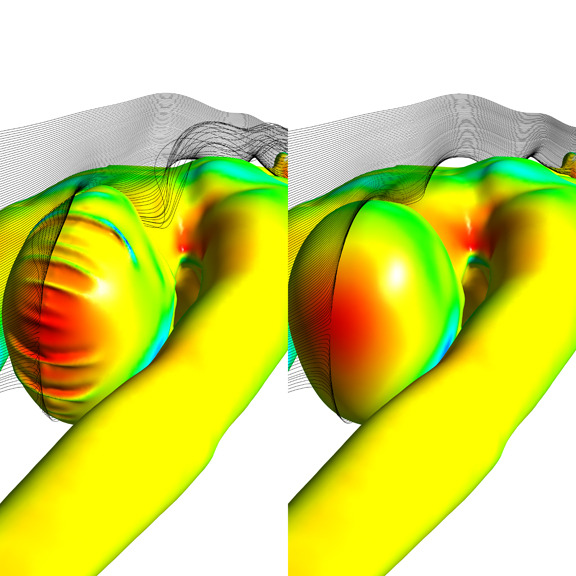Latest News
August 15, 2012
Stephen Silvester, a consulting services engineer working for ANSYS, has not personally met the U.S. Olympic swim team, but he knows many of them inside-out, in a manner of speaking. He certainly knows how they would fit inside a Speedo swimsuit.
Because of his involvement with Speedo’s efforts to refine its professional swimwear line, Silvester has access to about 50 athletes’ body scans, saved in STL format. He can, upon request, initiate a lap in a virtual pool using a digitized version of Michael Phelps. The technology he uses is part of ANSYS CFD, the same simulation software aerospace and automotive manufacturers routinely use to improve their products’ performance in the air and on the road.
The use of CFD to simulate the airflow around a vehicle is an established practice. It’s a useful method to identify geometry in the car that increases drag. The lower the drag, the faster the car. So based on CFD results, automotive designers can make subtle changes in the styling of the hood, windshield, and bumpers to reduce drag. Recognizing the same principle could be used to improve swimwear, Speedo began employing CFD in its apparel design, as far back as 2004. (More on this in ANSYS’s online article, “Simulating Swimwear for Increased Speed,” ANSYS Advantage magazine, Vol II, Issue 2, 2008.)
“First we use simulation to understand how the suite performs, so Speedo knows how to improve the suit. Then we use it to evaluate the design ideas they had in how to modify the suit,” explained Silvester.
There is one glaring difference in how CFD is used in traditional engineering projects and how it’s used by Speedo. “Design optimization for SUV version 1 will be still applicable for SUV 2, for the most part,” Silvester said. “With swimmers, no two swimmers are alike. You’re optimizing for an organic shape.”
With vehicles, simulation input parameters such as velocity, wind resistance, and air pressure are fairly consistent. With swimmers, each swimmer has his or her unique style. Mathematically recreating Michael Phelps’ strokes and paddles in the water is a lot more complex.
The Speedo-ANSYS partnership produced an ultra-lightweight, water-repellent suit called LZR Racer. (LZR is pronounced Laser.) According to Speedo, the product has 10% less passive drag than the Fastskin launched before the 2004 Olympics. Phelps described the feel of LZR Racer as “like a spacesuit” (”New suit set to make big splash for Michael Phelps,” February 2008, USA Today).
The advantage offered by the suit was significant enough to cause FINA, the international governing body of swimming, to take a closer look. In March 2009, FINA issued an edict banning full-body suits that it considered to be performance-enhancing in world championships. Later, in July 2009, it reversed its policy, but stipulated that swimwear must be made of “textile.” Industry observers point out that FINA has yet to define what it means by “textile.” Speedo’s LZR Racer and other Fastskin competition suits are considered FINA-compliant.
Taking its swimwear a step further, Speedo now enlists ANSYS to improve the entire line of swim gear, comprising caps, goggles, and suits. Using high performance computing (HPC) hardware, ANSYS performed roughly 1,200 simulation exercises, featuring hundreds of swim gear designs with a few millimeters’ difference among them.
“We cannot possibly test out all these ideas in real life,” said Silvester. “In the real world, without simulation, we’d have to accept that we cannot test out all the designs.”
But in CFD software running on computing clusters with 12-24 cores, it is, in fact, possible to test and prove hundreds of design variations in parallel. All details that seem to make a difference in swim performance—from the seam’s location on the suit to the corner of the goggles and the way the swimmer tucks his or her hair into the cap—were carefully studied for possible refinement.
The project resulted in “The Fastskin3 cap, the Fastskin3 Super Elite goggle, and the Fastskin3 Super Elite swimsuit [that] can deliver a full-body passive drag reduction of up to 16.6%, an 11% improvement in the swimmer’s oxygen economy, enabling them to swim stronger for longer, and a 5.2% reduction in body active drag.”
In his article “Dressed for Success” (ANSYS Advantage, Volume VI, Issue 2, 2012), Silvester pointed out that “During the 2008 Beijing Summer Olympics, 47 gold medals—and 89 percent of all swimming medals—were won by athletes wearing Speedo LZR Racer.”
Tom Waller, head of Speedo’s Aqualab, said, “For the first time, competitive swimmers can use a cohesive, hydrodynamic solution that will help them cut through the water with maximum efficiency. In developing the Fastskin Racing System, ANSYS software gave us the confidence that our designs would perform as expected in the real world—and saved us a huge amount of resources that we would otherwise have had to invest in physical testing.”
Silvester, who spent many hours recreating Olympic swim champions’ laps inside the computer, reveals swimming isn’t his preferred hobby. “You’d be lucky to find me in a swimming pool,” he said. When not running CFD jobs, he likes to fly as a private pilot.
Subscribe to our FREE magazine, FREE email newsletters or both!
Latest News
About the Author
Kenneth Wong is Digital Engineering’s resident blogger and senior editor. Email him at [email protected] or share your thoughts on this article at digitaleng.news/facebook.
Follow DE








